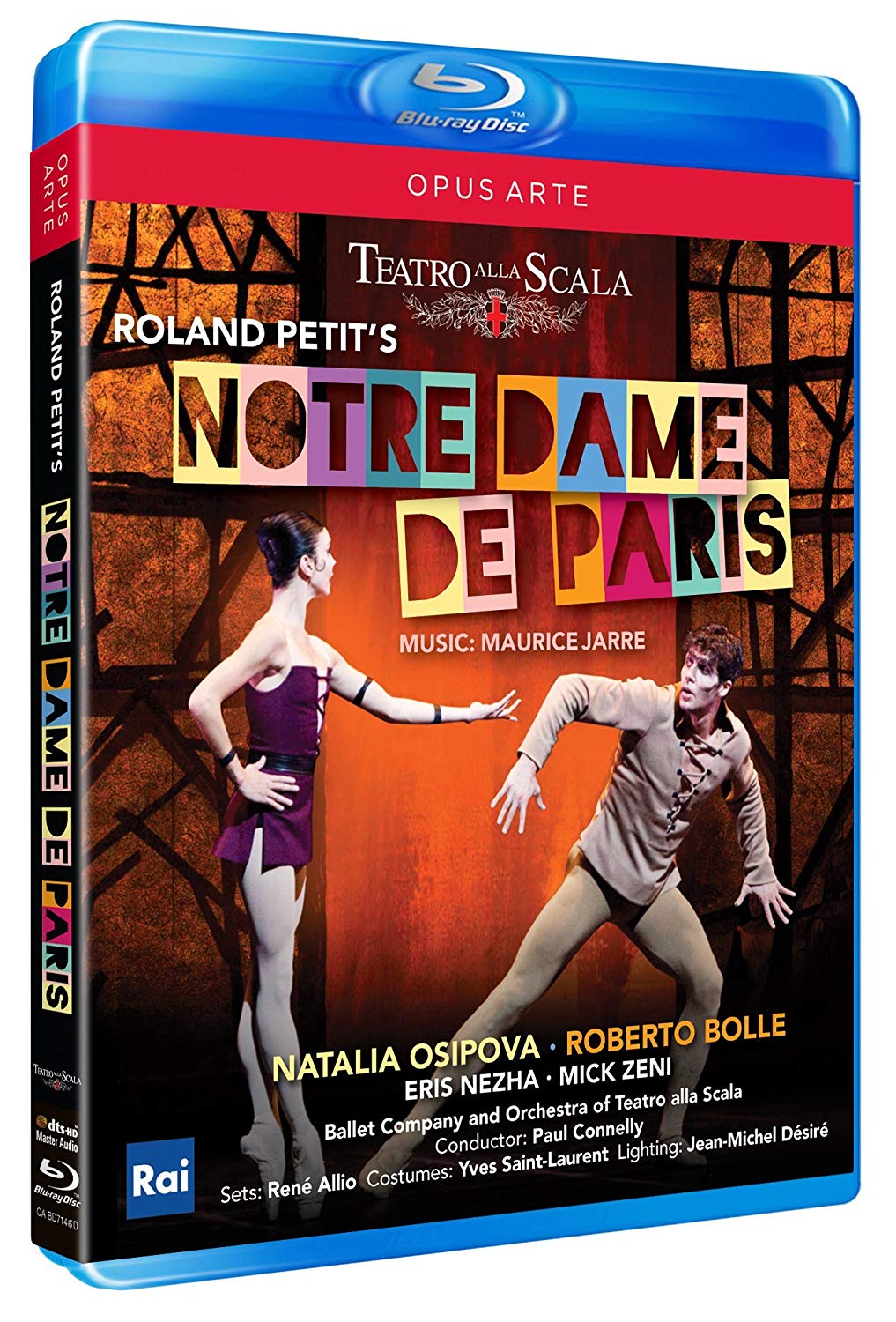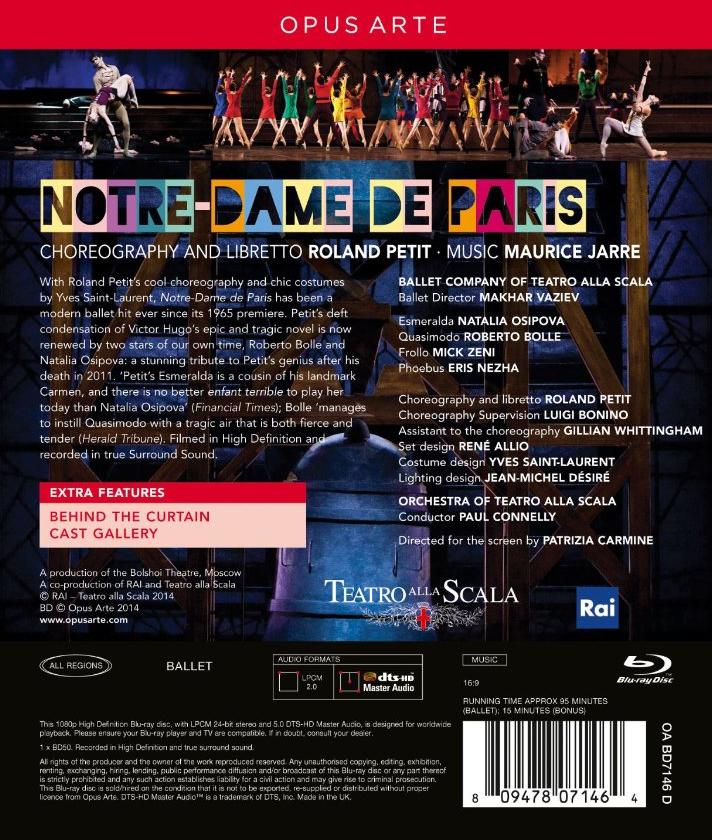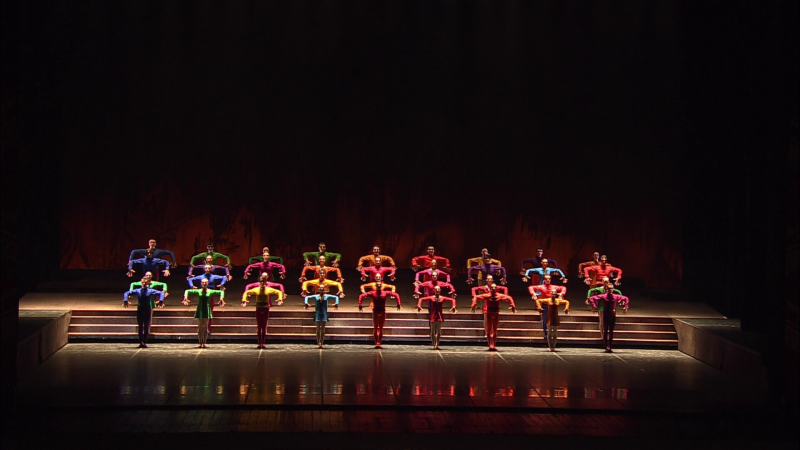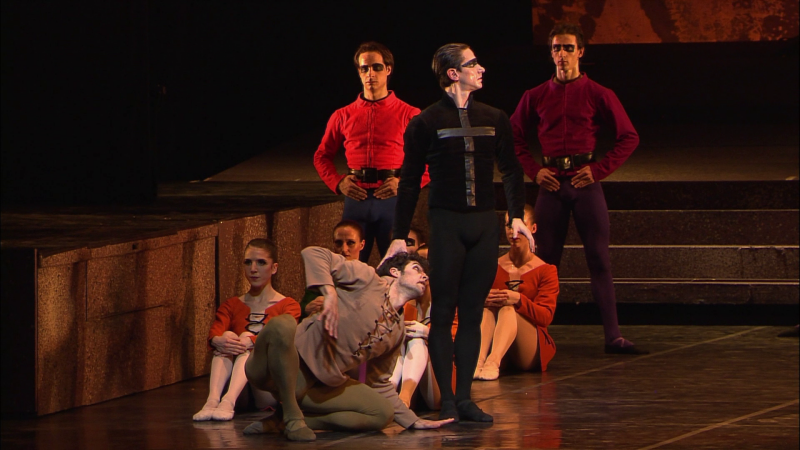

Notre-Dame de Paris ballet to music by Maurice Jarre. Libretto and choreography from Luigi Bonino and assistant Gillian Whittingham after 1965 version by Roland Petit. Stars Roberto Bolle (Quasimodo), Natalia Osipova (Esmeralda), Mick Zeni (Frolio), Eris Nezha (Phoebus), and dancers of the Ballet Company of Teatro alla Scala. Paul Connelly conducts the Orchestra of Teatro alla Scala. Sets designed by René Allio; costumes designed by Yves Saint-Laurent; lighting design by Jean-Michel Désiré. Directed for the screen by Patrizia Carmine. Released 2014, disc has 5.0 dts-HD Master Audio sound. Grade: B+
Notre-Dame de Paris is the name of Victor Hugo's novel; it's called The Hunchback of Notre Dame in the English translation. The ballet by Roland Petit depicts a much-simplified version of part of the rich book. The ballet isn't even mentioned by Jennifer Homans in Apollo's Angels, but I think it was a hit in Paris for the Paris Opera Ballet when it was first run at Palais Garnier in 1965. It was performed many times over the years in Paris, and had some success in other venues. There are several DVDs.
Many of the persons credited above, such as Yves Saint-Laurent, are now deceased. Yves was just starting his high fashion career in 1965. But his remarkable designs for this ballet together with his later astounding fame made Notre-Dame de Paris into a museum piece. The whole point of doing this now is to recreate the work as it was seen in 1965 but with the latest technology and hottest stars.
If you asked 1000 well-dressed people to name the most beautiful man in history, most would probably answer "Michelangelo's David." But 1st runner-up would surely be Roberto Bolle. And what greater challenge could there be for Roberto, having spend his entire life being and moving beautifully, than to dance the role of the hunchback? La Scala management had to do this now, before Roberto got any closer to injury or retirement. And who could be a better co-star for Roberto than guest artist Natalia Osipova, formerly with the Bolshoi and now with the Royal Ballet?
Before we get into further discussion of the show, I have a pop quiz. (Answers at the end of the story.)
Q 1. Which of the three 1965 dresses below was designed by Yves Saint-Laurent?
Q 2. Who was this lady?
Q 3. More colors. What famous artist exhibited this wall-size display?
The purpose of the pop quiz is to get you into a 1965 mood, even if you were born after that year. Bright colors and jaunty, geometric designs were the rage in Europe and the United States. Now on to our review.
This is the title screen for Notre-Dame de Paris. It looks a bit like the colors behind the lady above, don't you agree?
I don't remember showing splash screens on this website before, but these examples are so neat, I couldn't resist:
Paris in about 1482 (not a typo)—even the people were geometric:
Standing in black is Frollo (Nick Zeni), the Archdeacon of the Notre-Dame Cathedral. As an act of genuine compassion, Frollo took in a horrible deformed baby boy. This infant grew up to be Quasimodo (Roberto Bolle), the hunchback. Quasi became the bell-ringer at the Cathedral and thereby lost his hearing. He has a similar relationship to Frollo as Frollo has to God:
Paris celebrates the Festival of Fools:
When Quasi joins the crowd, the people cruelly elect him the "Fool's Pope."
The innocent Quasi is happy to the center of attention and doesn't know the crowd is making fun of him:
How many operas and ballets have a gypsy girl? This one is Esmeralda (Natalia Osipova), who dances in the square at the Cathedral for the Fool's Pope:
Quasi enjoys the dance, but the one who is smitten is Frollo. He even has 1965 geometric makeup:
Frollo orders Quasi to find Esmeralda and abduct her. But Esmeralda lives in the the Paris Den of Thieves, which is unfamiliar territory to our poor hero:
Phoebus (Eris Nezha) is captain of a company of archers who appear to be a kind of mounted police force. Phoebus sees a target of opportunity when he spots the hideous Quasi carrying away the beautiful Esmeralda. Phoebus moves in to woo the girl and the soldiers get to beat up Quasi:
Esmeralda falls in love with Phoebus. But she also feels compassion for Quasimodo and gives him water to drink from her hands. Now Quasi is also in love with Esmeralda:
Quasi is still a prisoner of the archers. Frollo looks for Esmeralda, and there follows an elaborate pas de trois:
Insane with lust, Frollo stabs Phoebus in the back and and kills him. To save his own skin, Frollo charges Esmeralda with the murder. Justice is swift, and below we see Esmeralda at the gallows. But Quasi seizes Esmeralda from the scaffold and manages to get her inside the Cathedral, where the law grants her sanctuary. In celebration of his dramatic rescue, Quasi rings the Cathedral bells:
Esmeralda senses the beautiful, brave soul inside Quasi's ugly body, and they dance a grotesque but touching pas de deux:
Until Frollo makes one last and futile effort to impose himself on Esmeralda:
Quasi is horrified to realize he is trapped between the only two people he has ever loved:
Frollo gets a repeal of the the law of cathedral sanctuary. Esmeralda is arrested again and taken to the gallows anew for her execution. Both the people Quasi loves die at the same time:
Now Quasimodo will be completely alone with his bells:
SQ is fine. PQ quality and video content in excellent with a good mix of long-range, mid-range, and near shots plus fine close-up images when appropriate.
The Maurice Jarre composition is relentlessly hard-driving. The orchestra fills the entire pit and has a huge percussion section. I thought I heard some impressive choral singing and also an organ, but nothing is said about this in the program notes. The score is not something I would want to listen to as stand-alone art. But it's skillfully done in the manner of movie music. It also matches well with the brutal plot from Victor Hugo, the rash, bold, angular visual designs, and the choppy, intense, small steps and wild use of limbs and hands called for by the choreographer.
Nothing in this production would have any connection to the culture of the middle ages, but it all fits together as a satisfying way of telling a story set in that era! This is in itself a bit surprising to me, but even more surprising is the fact that the production doesn't seem unpleasantly out-of-date even after 50 years of fair wear and tear. Still, I don't forget that this production honors the original staging in 1965. In 1965, this must have seemed ferociously audacious. But audacity has a short half-life. Grade: B+.
OR
Answer to Q 1: The dress in the center was by Yves. Straight lines, tunics, bold colors, and geometric designs were hot in 1965.
Answer to Q 2: The lady is Giuliana Benetton, who with her 3 brothers started the United Colors of Benetton in 1965. Note the grid of colors in the background, a design element used in the title screen for this HDVD.
Answer to Q 3. Gerhard Richter, who produced many color grids beginning in 1966. His most famous work of this type is the stain glass windows for the Cologne Cathedral with 11,500 squares of glass in 76 colors.
These Q&As suggest that the same design ideas were being pursued all over (France, Italy, and Germany) in 1965. The Yves designs for Notre-Dame de Paris were perhaps not all that original, but his genius for beautiful execution shines even today.





























